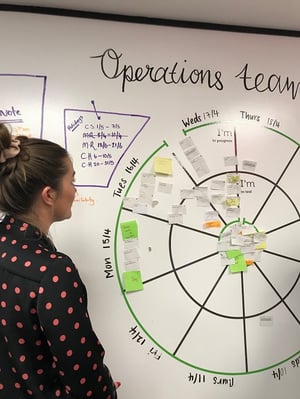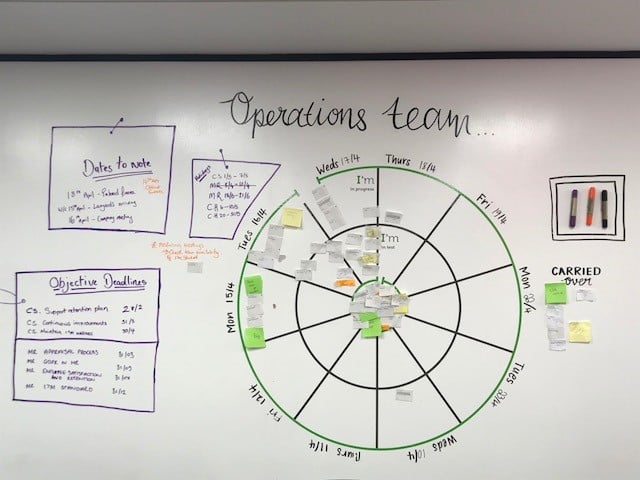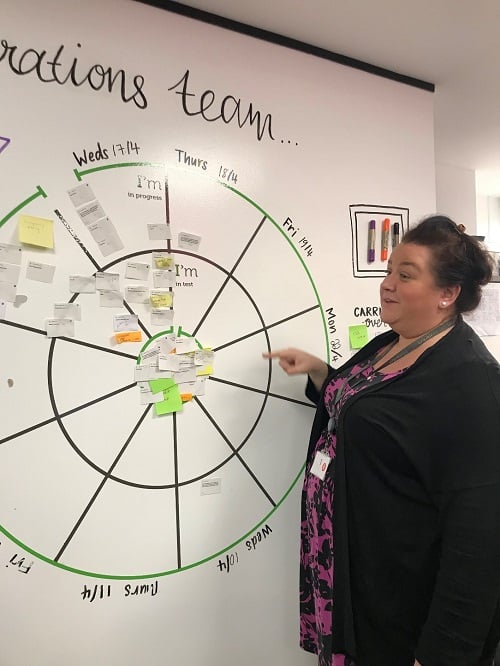'There is nothing more powerful in any organisation than having all employees rowing fiercely in the same direction', wrote Brent Gleeson, the founder of Taking Point Leadership. The same can be also applied to teams within any organisation. Long meetings, endless back and forth emails, misunderstandings, and interruptions for impromptu catch ups are symptoms of an inefficient internal department.
The goal of the Head of Operations, was to create a working environment that nurtures collaboration and confidence, allowing efficient and effective delivery and continuous improvement.
Infomentum’s Operations department covers HR, Finance and Office Management and consists of a team of four. The team has a set of tasks to be completed often on a monthly basis, with ad-hoc tasks thrown into the mix. While some tasks need input from all team members, others require the attention of only a few and so on, before going to review. There are tasks that depend on external suppliers or members of the team outside of Operations.
How do you effectively achieve productivity and good communication within a cross-functional department that delivers across multiple sectors of the business?
“I like the visual aspect of Agile, being able to see the plan. I also like how Agile allows us to be flexible, allowing the ad-hoc work to be prioritised with a view on how this affects the plan.”
- Caroline Hooper, Head of Operations
Infomentum live and breathe Agile methodology, therefore, adopting Agile was the most logical step for the Operations team. We use it as a tool to streamline processes, improve communications and make the Op’s team the most efficient it has ever been. The question is, how a methodology created for software development could be applied to Operations?
How to apply Agile to Operations
We started by getting the experts on board! Infomentum's highly experienced and knowledgeable Scrum Masters were happy to help and educate us about the meaning of Agile goals, principles and practices. The next step was to use Jira software for setting up our own Operations project. We also created a backlog of stories linked to sub-tasks or tasks depending on how small or large they are and/or how well they group together.
Months are divided into Sprints for ‘Finance’ and ‘HR’ although, as is the nature of Operations, there is a cross over between the two. Sprint planning sessions enable the team to plan tasks for each sprint, always keeping in mind availability and taking away or adding more tasks, accordingly. We have a dedicated internal Scrum Master focused on managing the project on Jira and keeping the Scrum Board always up-to-date.
“Being Agile helps us plan, it’s good that we stand up every morning and discuss priorities for the day. It helps to prevent any blockers and it’s nice that we can work in the same way as the rest of the company which promotes consistency”
- Molly Reason, HR Executive

Molly Reason, HR Executive says, “Being Agile helps us plan, it’s good that we stand up every morning and discuss priorities for the day. It helps to prevent any blockers and it’s nice that we can work in the same way as the rest of the company which promotes consistency”
Agile is about adapting to change. In any busy workplace tasks that need immediate attention can come up without notice. A daily contingency is kept for any ad-hoc tasks that may come along including supporting the rest of Infomentum. This approach allows the Op’s team to be flexible whilst keeping up with daily and monthly tasks, ensuring that deadlines are always met.
Alexis Carrel, the French-American surgeon and Nobel Prize winner, once said, 'The most efficient way to live reasonably is every morning to make a plan of one's day and every night to examine the results obtained.' A daily stand up allows the team to recap on the day prior, examine the success of the activities and to communicate the current days' plans. One of the core principles of Agile is to work at a constant pace, thereby giving consistent output. Any blockers can be immediately resolved, enabling the river of work to keep flowing.
The daily stand up is also a perfect time to share ideas, and ask for inspiration, request help and have a general catch up on the week’s events. Being Agile means doing instead of being paralysed by over-planning. Lengthy meetings or email communications are replaced by 15 minutes of effective communication.

Operations team's Agile board
This meetings of the minds take place in front of a scrum board. The tasks are added at the start of the sprint to planned delivery dates and then moved according to their state - ‘in progress’, ‘in review (test)’ or ‘done’. The scrum board also serves as a visual for important dates to note, holidays, and objective deadlines. It’s a place to write notes for other team members or brainstorm ideas for the latest company monthly goal. It’s a hub of communication, giving a snapshot of Operations’ current contribution to the company.

“I like the visual aspect of Agile, being able to see the plan. I also like how Agile allows us to be flexible, allowing the ad-hoc work to be prioritised with a view on how this affects the plan.” Caroline Hooper, Head of Operations.
A great man once said, “Learn from yesterday. The important thing is not to stop questioning” (Albert Einstein). Greater visibility and openness allow the team to recognise inefficient processes and to focus on improving them. Recently, the automation of monotonous and time-consuming financial reports has allowed the team to spend time on other things such as research and training. We can now apply our energy to areas that greatly benefit the business and all our employees, for example, improving the benefits package, streamlining the recruitment process, or refining company standards.
Adopting Agile approach is a testament to the scalability of the Agile methodology and the openness of the Operations team to innovations. Re-directing time and energy, streamlining communications, and making Operations more productive and nimbler, means that the future looks bright for the team.
We are very proud of what we have achieved but always looking for new ideas that could further improve the Operations team productivity. Now that’s Agile!
Read more:




-1.png)


